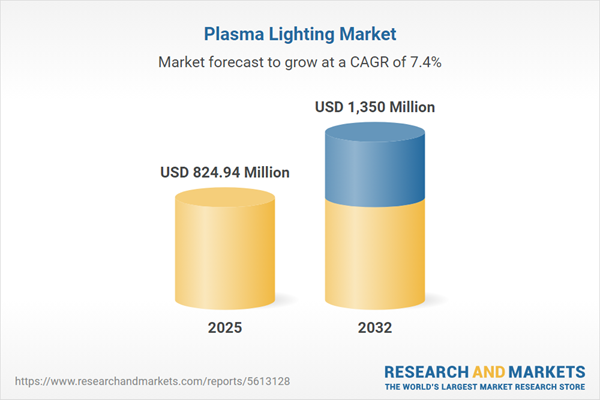Speak directly to the analyst to clarify any post sales queries you may have.
Senior decision-makers focused on future-proofing enterprise operations increasingly recognize the plasma lighting market as a strategic lever for enhancing facility performance, energy efficiency, and regulatory compliance. As organizations intensify modernization efforts, plasma lighting is positioned as a versatile solution for operational sustainability and efficiency.
Market Snapshot: Plasma Lighting Market Growth and Opportunity
The plasma lighting market is expected to experience steady growth from 2024 to 2032, supported by a strong compound annual growth rate and expanding across multiple commercial and industrial use cases. With rising demands for advanced lighting, enterprises are prioritizing solutions that support new regulatory frameworks on sustainability and elevate operational efficiency. Plasma lighting appeals due to its durability in challenging environments and its ability to integrate with existing facilities or emerging infrastructure. Its compatibility with building management systems enhances adaptability and supports ongoing regulatory shifts. These attributes, combined with expanding investment in modernization across industries, underscore why plasma lighting is gaining traction among executive stakeholders.
Scope & Segmentation of the Plasma Lighting Market
This analysis offers targeted, actionable insights for senior leaders by detailing the primary segments, technology variants, and regional trends affecting plasma lighting adoption in global markets:
- Applications: Effective for both expansive and precision-lit spaces, including studios, sports venues, warehousing, city exteriors, and any area requiring dynamic or static illumination.
- End User Industries: Suited for sectors such as hospitality, commercial offices, retail, manufacturing, infrastructure, real estate, and specific residential complexes prioritizing occupant comfort and efficiency.
- Lamp Types: Includes external ballast and self-ballasted models that address various facility management and control integration needs.
- Distribution Channels: Enterprises can procure via direct purchases, certified resellers, or online marketplaces, supporting governance standards and procurement requirements.
- Power Ratings: Offerings range from energy-saving low-power units to robust, high-output lamps for large-scale and industrial deployments.
- Installation Types: Supports both new construction and retrofit applications to fit different infrastructure and control environments.
- Regions: Addresses the Americas, Europe, Middle East, Africa, and Asia-Pacific, focusing on local regulation, procurement strategies, and infrastructure conditions influencing adoption.
Segment insights highlight plasma lighting’s relevance for organizations seeking solutions tailored to operational goals, technical priorities, and compliance standards across diverse sectors and geographies.
Key Takeaways for Senior Decision-Makers
- Plasma lighting delivers long-term reliability in mission-critical contexts, reducing operational interruptions in logistics, industrial, and professional environments.
- Extended lamp lifespans and simplified maintenance apply to organizations managing continuous or large-scale operations, supporting asset longevity and cost control.
- Deployment supports rapid adaptation to emerging sustainability mandates and evolving corporate governance requirements.
- Integration with centralized building management systems enables real-time oversight and facilitates systematic planning and upkeep processes.
- Engineered for international compliance, plasma lighting helps organizations reduce risk from regulatory or supply chain disruptions across multiple markets.
- Flexible supplier arrangements allow enterprises to expand or adapt lighting infrastructure efficiently, supporting business agility and operational resilience.
Tariff Impact on Plasma Lighting Supply Chains
New tariffs anticipated in the United States for 2025 may affect supply chain costs for plasma lighting procurement. In response, leading organizations are diversifying supplier networks, growing domestic production capacity, and forging regional assembly partnerships. Proactive procurement strategies and active management of supplier relationships foster resilience, safeguarding against regulatory disruptions and unpredictable shifts in market conditions.
Methodology & Data Sources
The report integrates insights from executive interviews, technical consultations, and comprehensive industry research. Validation includes reviews by domain experts and examination of patent and regulatory trends to ensure findings are actionable and strategically focused for enterprise requirements.
Why This Report Matters for Enterprise Stakeholders
- Equips organizations to address emerging value opportunities, enhance compliance, and realize stronger investments in lighting infrastructure.
- Strengthens organizational adaptability and resilience through informed responses to regulatory or tariff developments.
- Clear guidance on modernization and sustainability strategies aligns lighting upgrades with risk management and long-term operational objectives.
Conclusion
This report enables senior leaders to coordinate compliance, reinforce supply chain stability, and advance facility modernization as plasma lighting integrates with core enterprise infrastructure strategies.
Additional Product Information:
- Purchase of this report includes 1 year online access with quarterly updates.
- This report can be updated on request. Please contact our Customer Experience team using the Ask a Question widget on our website.
Table of Contents
3. Executive Summary
4. Market Overview
7. Cumulative Impact of Artificial Intelligence 2025
Companies Mentioned
The companies profiled in this Plasma Lighting market report include:- Novalux AG
- Xenon Corporation
- Excelitas Technologies Corp.
- Ushio Inc.
- Signify N.V.
- OSRAM GmbH
- GE Lighting LLC
- Hamamatsu Photonics K.K.
- Acuity Brands, Inc.
- PerkinElmer, Inc.
Table Information
| Report Attribute | Details |
|---|---|
| No. of Pages | 184 |
| Published | October 2025 |
| Forecast Period | 2025 - 2032 |
| Estimated Market Value ( USD | $ 824.94 Million |
| Forecasted Market Value ( USD | $ 1350 Million |
| Compound Annual Growth Rate | 7.3% |
| Regions Covered | Global |
| No. of Companies Mentioned | 11 |









